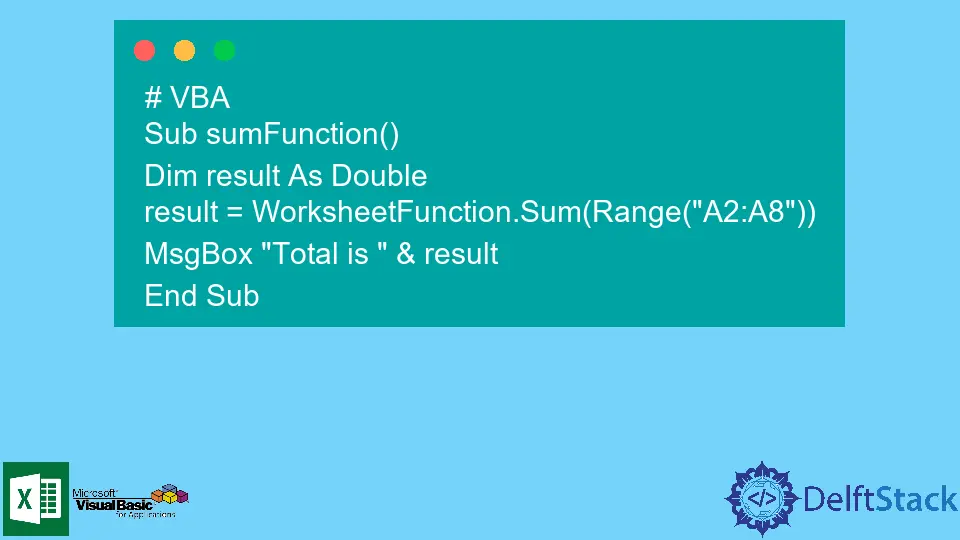The Sum() Function in VBA

When working with data in Excel or other Microsoft applications, the ability to perform calculations is crucial. The Sum() function in Visual Basic for Applications (VBA) is a powerful tool that allows you to efficiently add up numbers. Whether you’re automating reports or processing large datasets, understanding how to utilize this function can save you significant time and effort.
In this article, we will delve into various methods to sum values in VBA, providing practical code examples and explanations to help you grasp its usage. By the end, you’ll be equipped to implement the Sum() function in your own VBA projects with confidence.
Understanding the Sum() Function in VBA
The Sum() function in VBA is straightforward yet highly effective. It can be used to add numbers in a range, an array, or even individual values. This function is particularly useful when you’re dealing with large datasets, as it simplifies the process of tallying numbers without needing to manually sum each value.
Basic Usage of the Sum() Function
The most basic way to use the Sum() function is to sum a range of cells in an Excel worksheet. Here’s a simple example:
Sub SumExample()
Dim total As Double
total = Application.WorksheetFunction.Sum(Range("A1:A10"))
MsgBox "The total is " & total
End Sub
In this code, we declare a variable total to store the sum. We then use the Application.WorksheetFunction.Sum method to add up the values in cells A1 through A10. Finally, we display the result in a message box.
Output:
The total is [calculated total]
This method is highly effective when you want to quickly sum a range of cells without writing complex loops or conditions. The use of Application.WorksheetFunction allows you to leverage Excel’s built-in functions directly within your VBA code, making it a seamless integration.
Summing Arrays in VBA
Another powerful feature of the Sum() function is its ability to sum values in an array. This is particularly useful when you’re working with data that isn’t directly in a worksheet but is instead generated or manipulated in your code. Here’s how you can do it:
Sub SumArrayExample()
Dim numbers() As Double
Dim total As Double
Dim i As Integer
numbers = Array(1, 2, 3, 4, 5)
For i = LBound(numbers) To UBound(numbers)
total = total + numbers(i)
Next i
MsgBox "The total is " & total
End Sub
In this code, we first declare an array called numbers containing five numeric values. We then loop through the array using a For loop, adding each element to the total variable. Finally, we display the total in a message box.
Output:
The total is 15
This method of summing an array is particularly beneficial when you need to perform calculations on dynamically generated data. It gives you the flexibility to manipulate and sum values as needed, making it an essential technique in your VBA toolbox.
Using the Sum() Function with Conditional Logic
Sometimes, you may want to sum values based on specific criteria. For example, you might want to sum only the values that meet certain conditions. This can be achieved using the If statement along with the Sum() function. Here’s how:
Sub SumConditionalExample()
Dim total As Double
Dim i As Integer
For i = 1 To 10
If Cells(i, 1).Value > 5 Then
total = total + Cells(i, 1).Value
End If
Next i
MsgBox "The total of values greater than 5 is " & total
End Sub
In this example, we loop through the first ten rows of column A. We check if each cell’s value is greater than 5; if it is, we add it to the total variable. Finally, we display the total in a message box.
Output:
The total of values greater than 5 is [calculated total]
This approach allows you to sum values conditionally, providing a more tailored solution to your data processing needs. You can easily adapt the criteria in the If statement to fit your specific requirements.
Conclusion
The Sum() function in VBA is an invaluable tool for anyone looking to automate calculations in Excel or other Microsoft applications. Whether you’re summing ranges, arrays, or applying conditional logic, mastering this function can significantly enhance your data processing capabilities. By incorporating these techniques into your VBA projects, you’ll not only save time but also improve the accuracy of your calculations. Start experimenting with the Sum() function today, and watch how it transforms your workflow!
FAQ
-
What is the Sum() function in VBA?
The Sum() function in VBA is used to add up numbers, whether in a range, an array, or individual values. -
Can I use the Sum() function on non-contiguous ranges?
Yes, you can sum non-contiguous ranges by specifying each range in the function, like this:Application.WorksheetFunction.Sum(Range("A1, A3, A5")). -
How do I sum values based on conditions in VBA?
You can use a loop with an If statement to check conditions and sum values accordingly. -
Is the Sum() function limited to numeric values?
Yes, the Sum() function works only with numeric values. Non-numeric values will be ignored. -
Can I sum cells from different worksheets?
Yes, you can sum cells from different worksheets by specifying the worksheet name in the range, like this:Worksheets("Sheet2").Range("A1:A10").